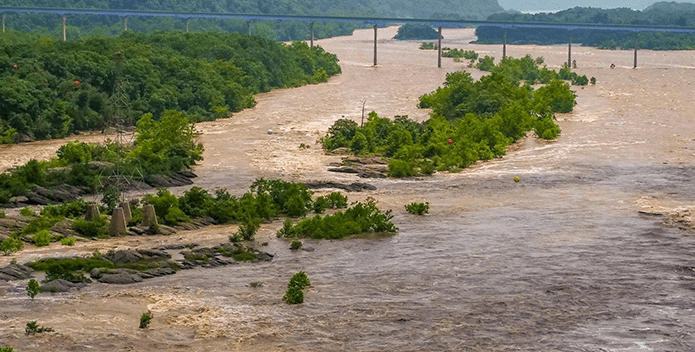Drone photographer John Pavoncello has pictured the Susquehanna River during its gentle rolling in the spring and bulging with jagged ice flows in winter.
But it was his fly-over during an angry, swollen, chocolate-tinted torrent of trees and debris in the summer that the veteran cameraman won't soon forget.
"You just don't get the perspective standing along the bank," Pavoncello said thinking about the magnitude of rushing brown water that he called "crazy."
Pavoncello's airborne perspective of the deluge of runoff during repeated severe storms that made this past July the wettest on record and continue into the fall, illustrates the power of water and the urgency to find solutions on the ground.
It just so happens that one of the most ambitious and challenging efforts to reduce the pollutant payload that flows into the Susquehanna, other Commonwealth waterways, and down to the Chesapeake Bay has taken root.
The Keystone 10 Million Trees Partnership is a collaborative effort, coordinated by the Chesapeake Bay Foundation, that intends to add 10 million trees to Penn's landscape before the end of 2025.
Trees alongside streams and streets are among the most cost-effective tools for cleaning and protecting waterways. They can also stem the tide of rushing waters that create so much flooding damage.
Upon maturity, 10 million new trees could mean 500 million to 110 billion gallons of precipitation are slowed, spread out and absorbed, or evaporated.
A 100-foot-tall tree can take 11,000 gallons of water from the soil and release it into the air as oxygen and water vapor in a single growing season.
In urban and suburban settings, a single deciduous tree can intercept from 500 to 760 gallons of water per year.
Trees filter and regulate the flow of water, in large part due to their leafy canopy that intercepts rainfall. Average interception of rainfall by a forest canopy ranges from 10 to 40 percent depending on species, age of the tree, time of year, and frequency and intensity of rainfall.
The soils beneath the tree canopy increase in organic matter, which allows for increased water absorption and infiltration.
The Keystone 10 Million Trees Partnership, launched in April, galvanized national, regional, state, and local agencies, conservation organizations, watershed groups, conservancies, outdoors enthusiasts, businesses, and individuals.
In the Partnership's first months, about 1,800 volunteers and CBF's restoration specialists planted 31,000 trees at more than 50 locations. More trees are being planted during the fall season through November.
In 2019, the Partnership hopes to nearly double its impact. That means that 50 planting partners will engage at 100 planting sites, 3,000 volunteers will be mobilized, and 50,000 trees will go into the ground next spring.
The Commonwealth has 19,000 miles of degraded streams, areas with some of the unhealthiest air in the nation and is among the most flood-prone regions in the country. The Keystone 10 Million Trees Partnership can address those challenges and more.
As for the mighty, muddy Susquehanna, there may never be enough trees to withstand such an extreme force of nature as seen through John Pavoncello's lens. But those lasting images should be a reminder that consequences downstream could be less "crazy" if more trees are working upstream.
To learn more about the Keystone 10 Million Trees Partnership visit www.TenMillionTrees.org.




